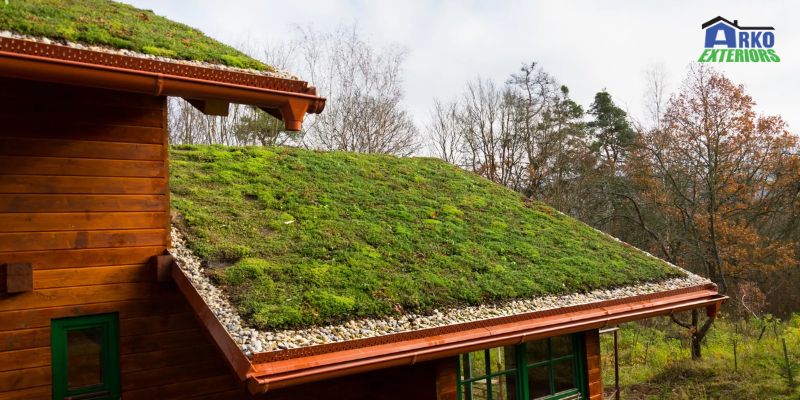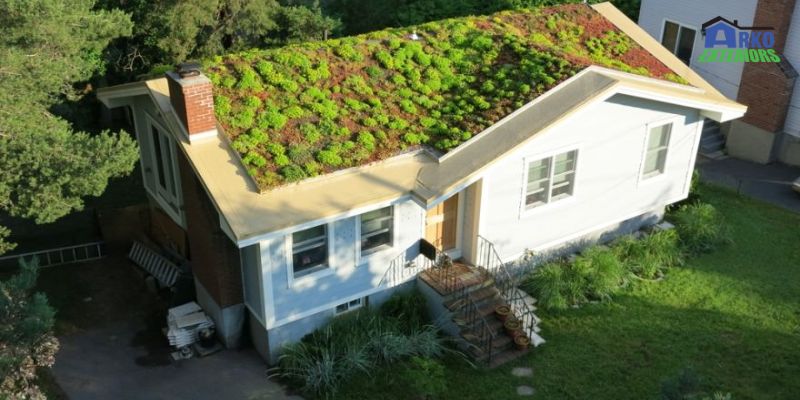As the world continues to grapple with the devastating effects of climate change, homeowners are increasingly looking for ways to reduce their carbon footprint and contribute to a more sustainable future. One area where this is particularly important is in the construction and maintenance of our homes. Green roofing has emerged as a popular and effective option for homeowners who want to make their homes more sustainable and environmentally friendly.
Green roofing systems involve the use of vegetation, soil and drainage layers to create a living “roof” on top of a building. Not only do these green roofs provide important environmental benefits such as improved air quality and reduced heat island effects, but they can also reduce energy costs and increase the lifespan of a building’s roof. Additionally, many municipalities offer incentives for homeowners who install green roofs, making them a financially viable option as well.
Benefits Of Green Roofing:

Green roofing, also known as a living roof, is a sustainable roofing option that involves covering a roof with vegetation, soil and a waterproof membrane. Green roofs can provide numerous benefits, including:
- Improved energy efficiency: Green roofs can help regulate temperature and reduce energy consumption by providing natural insulation and shading.
- Improved air quality: Vegetation on a green roof can help filter pollutants and improve air quality in urban areas.
- Reduced stormwater runoff: Green roofs can absorb rainwater and reduce stormwater runoff, helping to prevent flooding and erosion.
- Extended lifespan: A green roof can protect the underlying roofing materials from UV radiation, temperature fluctuations and other environmental factors, which can extend the lifespan of your roofing system.
Types Of Green Roofing:

There are two main types of green roofing: extensive and intensive.
Extensive green roofs are lightweight and require minimal maintenance. They typically consist of a shallow layer of soil and low-maintenance plants like sedum, grasses and mosses. Extensive green roofs are well-suited for sloped or flat roofs and can provide numerous environmental benefits without requiring extensive maintenance.
Intensive green roofs are heavier and more complex than extensive roofs. They typically include a deeper layer of soil and a wider variety of plants, including trees and shrubs. Intensive green roofs require more maintenance and can be more expensive to install, but they can provide additional benefits, like rooftop gardens, outdoor spaces and improved insulation.
Cost & ROI:
Green roofs can be more expensive to install than traditional roofing systems, but they can also provide a significant return on investment over time. While the upfront costs of a green roof may be higher, the long-term benefits of reduced energy costs, improved air quality and extended lifespan can offset the initial investment.
Additionally, many cities and states offer incentives and rebates for homeowners who install green roofs, which can help reduce the overall cost. It’s essential to consider the long-term cost and benefits when deciding whether a green roof is the right choice for your home.
Maintenance Requirements:
Green roofs do require maintenance to ensure that the plants and vegetation remain healthy and the roofing system remains functional. Maintenance requirements will vary depending on the type of green roof, the climate and the vegetation used.
Extensive green roofs typically require less maintenance than intensive green roofs, but they still require regular inspections and upkeep. Maintenance tasks can include removing debris, pruning plants, fertilizing the soil and monitoring for leaks or other issues.
It’s important to work with a roofing professional who has experience with green roofing systems and can provide guidance on the maintenance requirements. Proper maintenance is essential for the longevity and effectiveness of a green roof, so it’s important to factor in these maintenance requirements when considering a sustainable roofing option for your home.
Structural Considerations:
Green roofs can be heavier than traditional roofing systems, so it’s important to consider the structural capacity of your home before installing a green roof. A structural engineer can assess the load-bearing capacity of your roof and determine whether it can support the weight of a green roof.
In some cases, additional structural support may be necessary, which can increase the overall cost of the project. It’s important to consider these structural considerations when deciding whether a green roof is the right choice for your home.
Design & Aesthetics:
Green roofs can provide numerous environmental benefits, but they can also be visually appealing and enhance the overall design of your home. Green roofs can be customized to suit your style and aesthetic preferences, and they can add a unique and eye-catching element to your home’s exterior.
There are many design options available for green roofs, including different types of plants, flowers and vegetation. It’s important to work with a roofing professional who can provide guidance on the design and aesthetics of your green roof and ensure that it complements the overall style of your home.
Summary:
To sum it up, green roofing is a sustainable option for homeowners who want to contribute to the environment while adding value to their homes. It is a cost-effective solution that provides a variety of benefits such as reduced energy consumption, stormwater management, improved air quality and extended roof life. By opting for green roofing, homeowners can reduce their carbon footprint and make their homes more eco-friendly. As we move towards a more sustainable future, green roofing is a step in the right direction.

